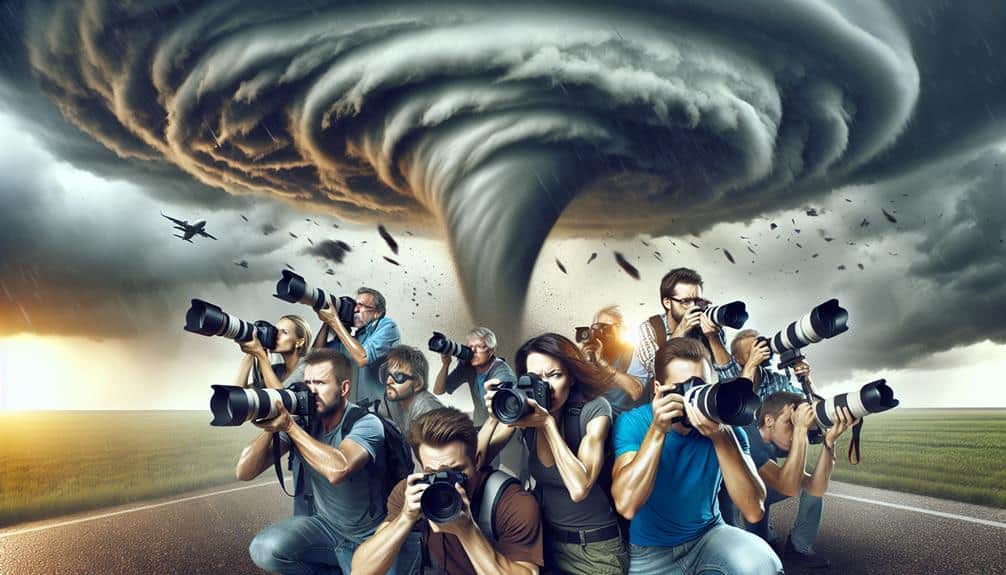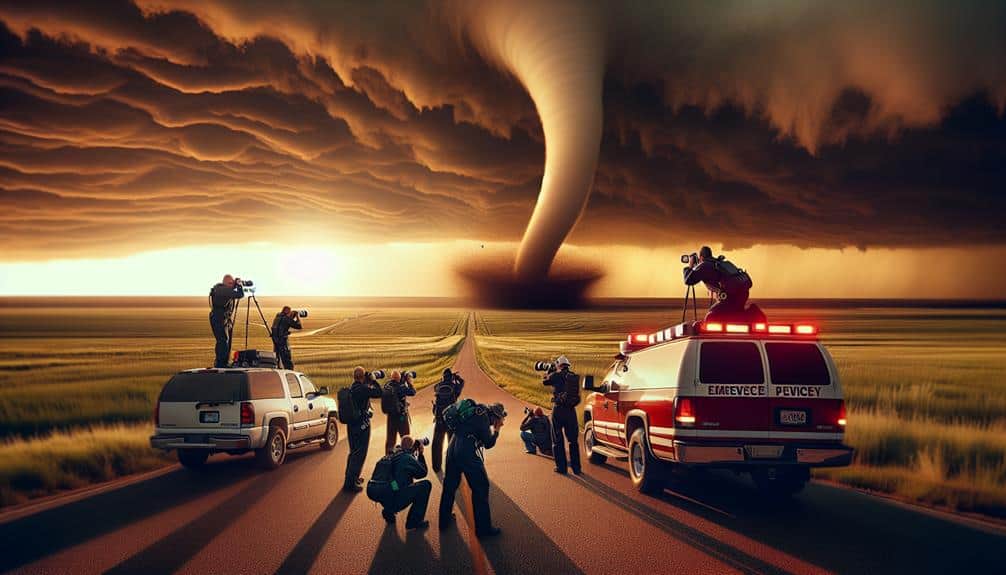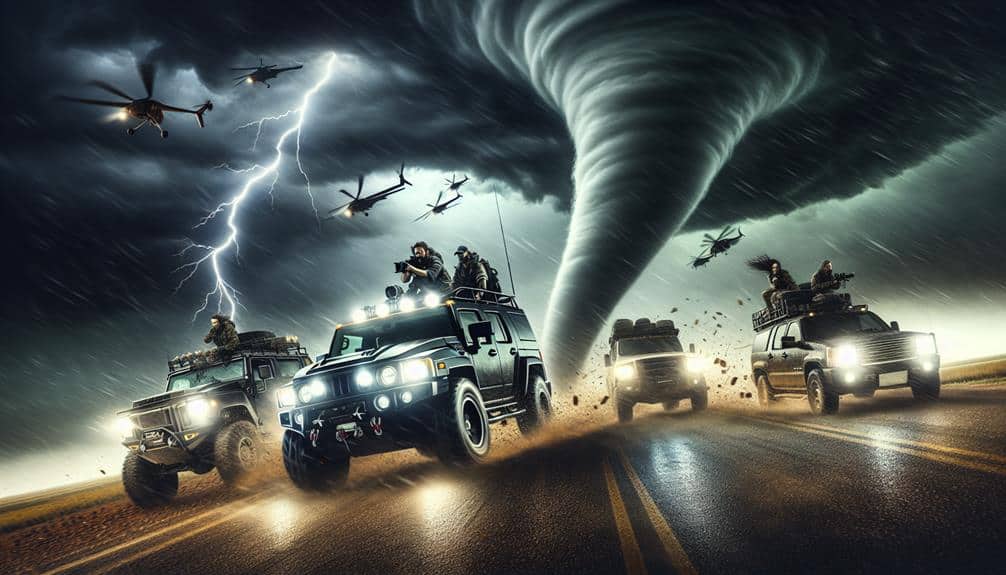We explore the thrilling lives of TV's top storm chasers, from their childhood fascinations with extreme weather to their rigorous training and cutting-edge technology. These chasers blend science and adrenaline, often facing near-misses and making split-second decisions in the heart of the storm. They meticulously prepare their gear, prioritize safety, and rely on advanced tools like Doppler radar and drones. Behind the scenes, it's a mix of grit, camaraderie, and a passion for nature's fury. Their stories of racing against nature and unforgettable chase experiences are just the start of what we've discovered.
Key Points
- Top storm chasers often cite childhood weather experiences as the spark for their passion and career in storm chasing.
- Behind-the-scenes footage reveals the critical role of communication and split-second decisions in ensuring safety during storm chases.
- Advanced technology, such as Doppler radar and high-speed cameras, is essential for tracking and documenting storms accurately.
- Preparation and gear maintenance are crucial for the safety and efficiency of storm chasers, ensuring they are ready for any scenario.
Origins of Top Storm Chasers
Many of TV's top storm chasers began their careers driven by a fascination with extreme weather and a desire to understand its mysteries.
Growing up, we might remember those moments when the skies darkened and the wind picked up, igniting a sense of wonder and excitement. Childhood experiences, such as witnessing a powerful thunderstorm or being captivated by weather documentaries, often planted the seeds of our passion for weather.
Early influences played a significant role in shaping our career decisions. For some, it was a parent or teacher who encouraged curiosity about meteorology. For others, it might've been a memorable encounter with a tornado or hurricane that solidified their determination to chase storms. These experiences fueled our thirst for knowledge and adventure.
As we pursued our passion for weather, we found that storm chasing offered a unique blend of science and thrill. It wasn't just about the rush of adrenaline but also about understanding the complex dynamics of nature.
We committed ourselves to rigorous study and training, knowing that our early influences and childhood experiences had set us on a path that combined our love for freedom with a relentless quest for discovery.
Behind the Scenes Footage
Let's take a closer look at what happens when the cameras aren't rolling.
We capture extreme weather, meticulously prepare our equipment and gear, and experience unseen on-set moments that highlight the real challenges and triumphs of storm chasing.
This behind-the-scenes footage offers an unfiltered glimpse into our world.
Capturing Extreme Weather
With cameras rolling, we plunge into the heart of the storm, capturing the raw power and sheer intensity that define extreme weather events. The adrenaline rush is incomparable. But it's not all thrill—we prioritize safety measures. Every step we take is meticulously planned, balancing the desire for jaw-dropping footage with our commitment to staying safe.
Before we even hit the road, risk assessment is key. We analyze weather patterns, studying radar data and storm projections to predict where the action will be. This preparation isn't just about finding the storm; it's about understanding its potential threats and knowing when to pull back. We're not reckless adventurers; we're calculated risk-takers.
Once we're in the field, our senses are heightened. We're in constant communication, updating each other on changing conditions and making split-second decisions. The challenge is to stay focused, capturing those perfect shots without compromising our safety.
Each storm is unique, a dynamic force that's both awe-inspiring and unpredictable. Through our lenses, we aim to share that raw, unfiltered experience with our audience, giving them a front-row seat to nature's most extreme spectacles.
Equipment and Gear Prep
Our journey into the storm begins long before we hit the road, meticulously prepping our equipment and gear to guarantee we're ready for anything. We start with gear maintenance, ensuring every camera, drone, and weather instrument is in peak condition. This involves cleaning lenses, checking batteries, and updating software. A single malfunction can mean missing a critical shot, so we leave nothing to chance.
Next, we organize our emergency supplies. Storm chasing is unpredictable, and we must be self-sufficient. We pack first-aid kits, flashlights, and enough food and water to last several days. Our vehicles are stocked with tools for quick repairs and spare parts for our equipment. Tire punctures and mechanical issues are common, so we carry jacks, wrenches, and extra tires.
Safety is paramount, so we also prepare our communication gear. Radios, GPS units, and satellite phones are checked and double-checked. Staying connected can make the difference between a close call and a catastrophe.
Every item we pack has a purpose, aimed at keeping us efficient and safe in the face of nature's fury. This rigorous preparation allows us to chase the storm with confidence and capture those breathtaking moments.
Unseen On-Set Moments
Behind the scenes, countless moments unfold that reveal the true grit and camaraderie of our storm-chasing team. We've had our share of bloopers and mishaps, from accidentally dropping expensive gear in the mud to miscommunications that send us dashing in the wrong direction. These moments, though frustrating, often end in laughter and bring us closer together.
One time, during an intense chase, a teammate's microphone picked up a spontaneous rendition of 'Eye of the Tiger' as we sped towards a storm. It's these light-hearted bloopers that keep our spirits high even when the weather conditions are anything but forgiving.
On the flip side, the close calls deliver an unparalleled adrenaline rush. We've had instances where twisters changed course unexpectedly, forcing us to make split-second decisions. Those heart-pounding moments remind us why we do what we do and how important it's to rely on each other.
The behind-the-scenes footage is a reflection to our resilience and the bond we share. It's not just about capturing the perfect shot; it's about enduring the chaos, laughing through the mishaps, and feeling the thrill of every near-miss together.
Memorable Chase Experiences

The thrill of racing against nature's fury has led us to some of the most unforgettable storm chasing adventures. Each chase delivers an adrenaline rush like no other, amplified by unexpected encounters that keep us on our toes.
We vividly remember a day when a seemingly routine chase turned chaotic as a massive tornado altered its course unexpectedly. Our hearts pounded, but our excitement was palpable.
Teamwork dynamics play an essential role in these high-stakes situations. Every member of our crew knows their role and executes it flawlessly. Communication is the backbone of our operation, allowing us to synchronize our movements and react quickly to changing conditions. When we're in the field, trust in each other's skills is paramount.
Safety protocols are our lifeline. From the moment we set out, we adhere to strict guidelines that ensure we stay out of harm's way while capturing the storm's raw power. We equip our vehicles with emergency supplies, and everyone is trained to handle worst-case scenarios.
This blend of thrill and caution defines our memorable chase experiences, making the storm chasing journey as secure as it's exhilarating.
Technological Tools Used
When it comes to storm chasing, we rely heavily on advanced radar systems to track severe weather patterns in real time.
High-speed camera equipment captures breathtaking footage that brings the intensity of storms to viewers at home.
These technological tools are game-changers, giving us the edge we need to stay safe and document nature's fury.
Advanced Radar Systems
Storm chasers rely heavily on advanced radar systems to track and predict severe weather with remarkable precision. These systems are our lifeline when we're out in the field, giving us the critical data we need to navigate treacherous conditions safely. Radar technology has evolved tremendously, and today's tools offer unparalleled accuracy in storm tracking.
One of the most important advancements has been the introduction of Doppler systems. These systems measure the velocity of precipitation particles, helping us determine the intensity and movement of storms. With Doppler radar, we can see the rotation within supercells, a key indicator of potential tornado formation. This capability greatly enhances our forecasting accuracy, allowing us to make informed decisions on when and where to position ourselves.
We also use mobile radar units that can be deployed directly into the path of a storm. These units give us real-time data, enabling us to adapt quickly to rapidly changing conditions.
The integration of radar technology into our vehicles means we can stay connected and informed, no matter where the chase takes us. It's this combination of advanced tools and our expertise that keeps us a step ahead of the storm, ensuring both our safety and the success of our missions.
High-Speed Camera Equipment
Capturing the raw power of a tornado requires high-speed camera equipment that can freeze even the fastest-moving debris in stunning detail. We rely on specialized cameras capable of shooting at thousands of frames per second. This allows us to capture every swirl and twist in the storm's anatomy. Adjusting the camera settings is essential; we often tweak the shutter speed and ISO to adapt to rapidly changing light conditions.
Drone footage has become indispensable for storm chasers. These agile devices give us a bird's-eye view of the storm's path, offering perspectives we simply can't achieve from the ground. High-resolution cameras mounted on drones provide crisp, clear images that are necessary for both analysis and breathtaking broadcasts.
Time lapse photography also plays a pivotal role in our work. By compressing hours of footage into mere seconds, we can showcase the storm's evolution in a visually dynamic way. The video editing process then allows us to highlight the most dramatic moments, ensuring our audience feels the storm's intensity.
In the end, our goal is to bring the awe-inspiring force of nature into living rooms, using the best technology available to tell the storm's story.
Challenges Faced on the Field

Braving extreme weather conditions is just one of the many challenges we face on the field as storm chasers. The unpredictability of storms demands rigorous safety measures. We constantly balance the thrill of getting that perfect shot with the need to stay safe. Our vehicles are equipped with reinforced structures, advanced weather tracking systems, and emergency supplies. We always have an evacuation plan in place, and everyone on the team knows their role in case things get hairy.
Team dynamics play a pivotal role in our success and safety. Each member brings a unique skill set, whether it's meteorology, photography, or driving. Communication is essential; we rely on clear, concise exchanges to make quick decisions. Trust within the team is indispensable. When you're facing nature's fury, there's no room for doubts or second-guessing. We all need to be in sync, like a well-oiled machine.
Facing these elements isn't just about the physical challenges. It requires mental resilience too. The relentless pressure can wear anyone down, but our shared passion for storm chasing keeps us going. Together, we embrace the risks and rewards, driven by the freedom of pursuing our dreams.
Future of Storm Chasing
As we look ahead, the future of storm chasing promises to be shaped by advancements in technology and a deeper understanding of meteorological phenomena. We're on the brink of a new era where climate change and safety measures will play pivotal roles.
First, we'll see greater accuracy in predicting severe weather patterns thanks to cutting-edge technology. This means:
- Enhanced radar systems: These will provide us with real-time data, enabling quicker and more precise response times.
- Drones: Equipped with cameras and sensors, drones will give us close-up views of storms without risking human lives.
- Artificial Intelligence: AI will sift through massive datasets, identifying patterns and anomalies faster than ever before.
- Mobile apps: Instant alerts and updates will keep us informed and safe, no matter where we are.
Climate change is altering storm behavior, making them more unpredictable and intense. We'll need to adapt our strategies and equipment to handle these new challenges. Safety measures will be paramount, with innovations like reinforced storm-chasing vehicles and better communication systems ensuring our well-being.
In this exhilarating field, our freedom to explore and document nature's fury is only expanding, as long as we embrace these advancements and prioritize safety.
Frequently Asked Questions
How Do Storm Chasers Handle the Emotional Impact of Witnessing Destruction?
We tackle the emotional impact of witnessing destruction by using coping mechanisms and seeking emotional support. Prioritizing mental health is critical, so we employ resilience techniques to stay strong and continue our essential work.
What Personal Safety Measures Do Storm Chasers Take During a Chase?
We always prioritize our safety by following strict emergency protocols and wearing protective gear. We stay informed about weather conditions and have evacuation plans ready. Our goal is to experience the thrill responsibly without compromising our safety.
How Do Teams Coordinate and Communicate During a Storm Chase?
In the eye of the storm, our team dynamics shine as we use seamless communication to navigate chaos. Quick decision making and adaptive strategies keep us aligned, ensuring we're always ready to chase the next thrill of freedom.
What Qualifications and Training Do Storm Chasers Typically Have?
We typically need a solid education in meteorology, hands-on experience in the field, and critical skills like data analysis and navigation. Certification in storm spotting or emergency response boosts our credibility and guarantees we're prepared for anything.
How Do Storm Chasers Fund Their Expeditions and Equipment?
We fund our expeditions through a mix of funding sources and sponsorships. Equipment costs are high, so we prioritize budgeting carefully. Partnering with brands and leveraging media deals helps us cover expenses while maintaining our independence.


